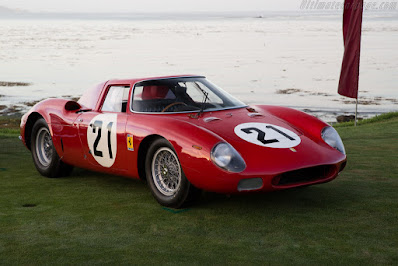Lesser KNOWN - Once upon a time, in a world where tires squealed louder than heavy metal guitar solos and speed limits were merely polite suggestions, a revolution in motorsport was quietly revving its engines. The landscape of racing was shifting fast—literally. The 1960s saw a tectonic change when rear and mid-engine layouts began to replace the traditional front-engine brutes of the past. Brands scrambled to keep up, and even giants like Ferrari, previously untouchable, suddenly found themselves being outpaced. The crown was slipping, and Maranello wasn’t going to let it hit the floor without a fight.
 |
| 1963 Ferrari 250 LM with chassis number of 5893 sat on display at the 2015 Pebble Beach Concours d'Elegance. (Picture from: UltimateCarPage) |
Ferrari had already ruled the racing kingdom with its 250 GT series. Models like the Ferrari 250 GT LWB (Long Wheel Base) from 1954 and the Short Wheel Base (SWB) from 1959 were masterpieces—lean, mean, trophy-gobbling machines. But as the decade flipped, the winds of change brought something that would rattle even the most finely-tuned egos: the rise of the mid-engine layout. And while Ferrari’s 250 GTO of 1962 was still seen as a jewel of engineering, its front-engine setup was starting to feel like wearing bell-bottoms in a room full of skinny jeans.
 |
| 1963 Ferrari 250 LM with chassis number of 5893 sat on display at the 2015 Pebble Beach Concours d'Elegance. (Picture from: UltimateCarPage) |
The folks at Maserati clearly didn’t get the “let Ferrari lead” memo and went full throttle into the future with the mid-engined Tipo 63 in 1961. Naturally, this didn’t sit well with Enzo Ferrari and his team. While Maserati was doing engine yoga and putting everything behind the driver for better balance, Ferrari was still stubbornly polishing its beloved front-engined icons. That is, until the realization finally screeched into the pit lane: evolve or be lapped.
 |
| 1963 Ferrari 250 LM with chassis number of 5893 sat on display at the 2015 Pebble Beach Concours d'Elegance. (Picture from: UltimateCarPage) |
Now, let’s not confuse the 250 LM with its cousin, the Ferrari 250 P. While they shared some DNA and a flair for looking devilishly handsome, the 250 LM sported a proper roof and a more robust chassis. It was, in other words, the practical older sibling who still knew how to party. And party it did—first making its public debut at the 1963 Paris Auto Show where it likely left onlookers drooling into their espresso.
 |
| 1963 Ferrari 250 LM with chassis number of 5893 sat on display at the 2015 Pebble Beach Concours d'Elegance. (Picture from: UltimateCarPage) |
By 1964, the 250 LM was ready for the track—and for the paperwork. Ferrari submitted it to the FIA for GT class homologation, assuming they could slide it in as a continuation of the 250 lineage. Here’s the kicker: while the prototype featured the 3-liter engine (justifying the “250” name), the production model was actually bumped up to 3.3 liters. Technically, that would’ve made it a “275 LM.” But let’s be honest—“275” just didn’t roll off the tongue quite the same way, and Ferrari had a bit of a history of naming things however they darn well pleased.
The FIA, unimpressed by Ferrari's semantic gymnastics and unconvinced they’d produce the required 100 units, slammed the brakes on the GT homologation. Ferrari ended up making just 32. That’s right—32. So yes, the FIA called it, and the 250 LM was instead shuffled into the prototype class, where it faced stiffer competition and more complicated rivals, sometimes from Ferrari’s own garage. Imagine being so good you have to beat your own siblings just to win.
 |
| 1963 Ferrari 250 LM with chassis number of 5893 sat on display at the 2015 Pebble Beach Concours d'Elegance. (Picture from: UltimateCarPage) |
That Le Mans victory wasn’t just a big win; it was a historic exclamation mark. It was the last time Ferrari took an overall win at Le Mans. Ever. The kind of final flourish that movies are made of, minus the slow-motion explosions.
Today, with only 32 originals ever produced, the Ferrari 250 LM is rarer than a polite internet comment. That scarcity, of course, has sparked the usual chaos: replicas. Lots of them. And because humans can’t leave well enough alone, some cheeky individuals slapped original serial numbers onto those copies, causing confusion that still haunts collectors like a bad tattoo. It’s like musical chairs, but with millions of dollars on the line and a whole lot more yelling.
 Still, no amount of forgery or replica drama can dull the shine of the 250 LM’s legacy. It’s a car that captured a moment in racing history—a bridge between the old guard and the new wave. A machine that proved Ferrari could pivot, adapt, and still blow the doors off the competition. And even if the name didn’t quite match the engine size, the spirit of the car was undeniably, unmistakably Ferrari: bold, beautiful, and just a little bit rebellious.
Still, no amount of forgery or replica drama can dull the shine of the 250 LM’s legacy. It’s a car that captured a moment in racing history—a bridge between the old guard and the new wave. A machine that proved Ferrari could pivot, adapt, and still blow the doors off the competition. And even if the name didn’t quite match the engine size, the spirit of the car was undeniably, unmistakably Ferrari: bold, beautiful, and just a little bit rebellious.Because sometimes, it takes more than just horsepower to make history. Sometimes, you need a bit of drama, a dash of defiance, and just the right amount of engine in the middle. *** [EKA [13022021] | FROM VARIOUS SOURCES | WIKIPEDIA | ULTIMATECARPAGE ]
Note: This blog can be accessed via your smart phone.


